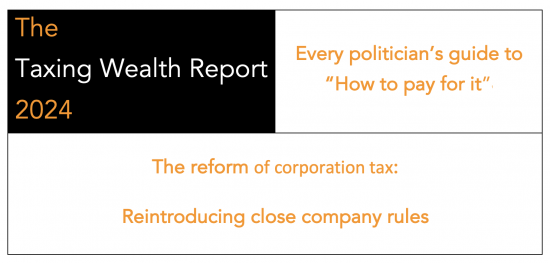[ad_1]
I have this morning published the next in my series of proposals that will make up the Taxing Wealth Report 2024.
In this latest note, I consider another change in the law that is required to tackle a significant tax avoidance activity that is primarily undertaken by the wealthiest in society. This is the retention of profits in private limited companies so that they might grow through the accumulation of retained profits within those entities that are only taxed at the relatively low rates charged on them when that same income would, if earned by the shareholders of the companies in question, have been taxed at much higher rates. A provision called ‘close company rules’ could tackle this issue.
The need for close company rules was recognised when corporation tax was introduced in 1965, but for most purposes the rules were abolished by 1984. The consequence has been a considerable increase in the income and wealth divide in the UK that needs to be tackled by their reintroduction.

The summary of this note says:
Brief summary
This note proposes that close company rules be reintroduced into UK taxation. It should be required as a result that:
- The income of all close companies with retained investment income and gains exceeding £50,000 should be required to distribute such sums to their members or they shall be deemed to have done so for income tax purposes.
- The retained profits of all close trading companies in excess of £200,000 not demonstrably being used for the purposes of a trade shall likewise be required to be distributed to the members of that company or shall be deemed to be so for income tax purposes.
For these purposes, a close company is defined as a company:
- under the control of:
- five or fewer participators, or
- any number of participators if those participators are directors.
- Or companies where more than half the assets of which would be distributed to five or fewer participators, or to participators who are directors, in the event of the winding up of the company.
A participator is usually a shareholder or director, although loan creditors can occasionally count if they have influence over a company.
Discussion
Provisions of the type noted here are surprisingly common. They are used in the USA, exist in the UK’s Crown Dependencies and exist in UK law already because this is the way in which UK limited liability partnerships are taxed.
However, to avoid the undue imposition of this law on the vast majority of UK small private limited companies de minimis limits are proposed for use as noted above.
That said, note that these de minimise limits are not set for a year: they do instead refer to retained profits from a source of income.
This law would essentially end the accumulation of investment income in private limited companies.
The same rule change would also require that private limited companies be required to justify the retention of their profits from trading to meet future business needs when they exceed the de minimis limit. The supply of a business plan and cash flow to HMRC should achieve that goal in most cases.
HMRC would be required to use a principles-based approach to appraising this issue. In other words, if it could be demonstrated that a close trading company has the clear intention to grow, requiring the retention of profit for investment in either fixed or working capital then, broadly speaking, a relaxed approach towards the application of this rule should be used by HM Revenue & Customs. In the absence of clear evidence on this issue, however, particularly over a period of time, HMRC must be empowered to act to require that profits are distributed or are deemed to be so, and that they would, therefore, become subject to tax in the hands of the shareholders of these companies.
Used in the way suggested these rules would end a very clear abuse that significantly increases the wealthy divide in the UK whilst simultaneously placing no obstacles in the path of a company that needs to retain funds to grow. That is why they are appropriate now.
Potential tax raised
Given the number of variables involved, it is hard to estimate the sums likely to be distributed, but if only £10 billion was distributed a year as a result of this policy (and that would appear to be a modest estimate), the likely increase in tax yield might be more than £3 billion a year at current tax rates, and somewhat more at the rates of tax proposed in the Taxing Wealth Report 2024, especially if an investment income surcharge was taken into account.
Cumulative value of recommendations made
The recommendations now made as part of the Taxing Wealth Report 2024 would, taking this latest proposal into account, raise total additional tax revenues of approximately £108.2 billion per annum.
[ad_2]
Source link



